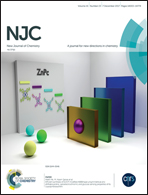Carbo[5]helicene versus planar phenanthrene as a scaffold for organic materials in OLEDs: the electroluminescence of anthracene-functionalized emissive materials†
Abstract
Aesthetically enticing helical structures are inextricable systems in biology, and have rapidly begun to pervade several aspects of materials science. The entry of helicenes in electroluminescent materials is very recent. In the present study, we have designed and synthesized two twisted carbo[5]helicenes functionalized with fluorescent phenylanthryl moieties, namely, CHMANT and CHDANT, for their applications as blue-emissive materials in nondoped OLED devices. Their lower analogs, i.e., PMANT and PDANT, based on a planar phenanthrene scaffold were also designed and synthesized to contrast the effect of helical versus planar cores in the development of emissive materials based on phenylanthracenes. It is shown that the helicenes functionalized with phenylanthryl group(s) not only display better fluorescence properties and thermal stabilities than analogous phenanthrenes, but also serve as superior emissive materials as well as host materials in electroluminescent devices. The comparative results bring out the fact that helicity (carbo[5]helicene) as a design element fares much better than a planar scaffold (phenanthrene) in developing anthracene-based emissive materials for OLEDs. The brightness (9820 cd m−2) and power and luminous efficiencies (3.48 lm W−1 and 4.22 cd A−1) obtained from a nondoped device fabricated with CHDANT are the highest by quite some margin among those of all helical materials reported so far.
![Graphical abstract: Carbo[5]helicene versus planar phenanthrene as a scaffold for organic materials in OLEDs: the electroluminescence of anthracene-functionalized emissive materials](/en/Image/Get?imageInfo.ImageType=GA&imageInfo.ImageIdentifier.ManuscriptID=C7NJ02233F&imageInfo.ImageIdentifier.Year=2017)


 Please wait while we load your content...
Please wait while we load your content...